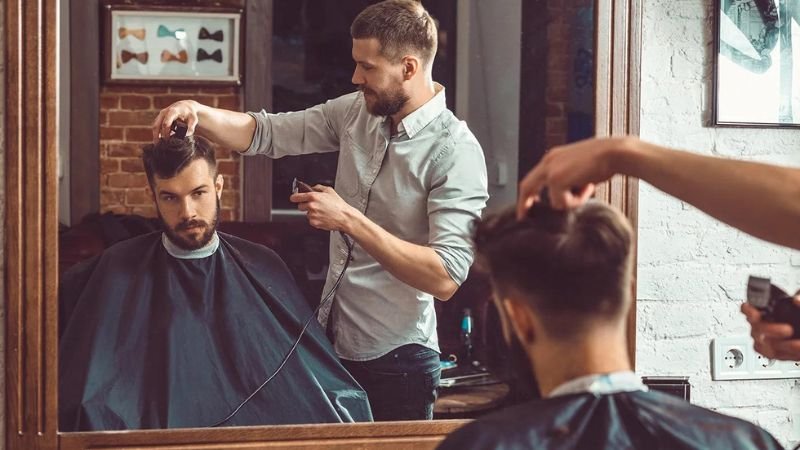Handling Difficult Clients – In a bustling barbershop, handling difficult clients while ensuring top-tier customer satisfaction can be a delicate balance. As a barber, you’re not just shaping hair—you’re managing personalities, expectations, and even emotions.
Knowing how to handle challenging clients is key to maintaining a positive atmosphere and a loyal customer base. Whether it’s dealing with picky customers, managing time-sensitive requests, or addressing complaints, these situations require tact, patience, and effective communication skills.
In this blog, we’ll explore seven practical tips that will help you navigate these challenges seamlessly. From setting clear expectations to practicing active listening and offering personalized solutions, these strategies will empower you to turn potentially negative encounters into opportunities for enhancing customer satisfaction and loyalty.
Read on to discover how you can keep your barbershop running smoothly, ensuring every customer leaves with a smile—even the tough ones.
7 Tips On Handling Difficult Clients
1. Set Clear Expectations from the Start
One of the most effective ways to handle difficult clients and maintain customer satisfaction is by setting clear expectations before the service begins. Miscommunication often leads to dissatisfaction, so it’s important to clarify what the client wants and explain what’s realistically achievable.
During the consultation, ask questions that dive deeper into the client’s preferences. For example, inquire about their past haircuts, likes, and dislikes, and what they expect from the current service. This allows you to address potential concerns before they become problems. Be transparent about what you can and cannot do, considering factors like hair type, face shape, or current hair health.
When clients know what to expect, they’re less likely to be disappointed, even if the outcome differs slightly from their vision. Setting boundaries around time constraints, pricing, and results also fosters a smoother experience. A well-informed client is typically a more satisfied client, so taking the extra time upfront to align on expectations can prevent disagreements and build trust.
2. Practice Active Listening and Empathy
Active listening is more than just hearing what the client says; it’s about fully understanding their needs and showing empathy. Many difficult situations arise because clients feel misunderstood or undervalued. When a client expresses their preferences or concerns, give them your full attention.
Avoid interrupting or assuming what they want—listen patiently until they’ve communicated their thoughts. Paraphrase what they’ve said to confirm that you’re on the same page. This step alone can build trust and reduce friction. Empathy also plays a critical role.
Try to put yourself in the client’s shoes, especially if they seem stressed, anxious, or unhappy. For instance, if a client had a bad experience elsewhere, acknowledging their feelings and reassuring them that you’ll do your best can help ease their concerns.
In addition, clients are more likely to accept your recommendations or solutions when they feel heard and respected. By fostering an environment where clients feel valued, you increase their overall satisfaction and make it easier to manage challenging situations.
3. Stay Professional and Calm Under Pressure
Dealing with a difficult client can test your patience, but staying professional and composed is crucial for diffusing tension and ensuring a positive outcome. As a barber, you’re often in close quarters with your clients, making it essential to maintain a calm demeanor, even in stressful situations.
If a client becomes confrontational or critical, avoid reacting defensively or emotionally. Instead, take a deep breath and respond in a measured tone. This not only de-escalates the situation but also shows that you’re in control, which can help the client relax.
Keep in mind that sometimes clients are projecting frustrations that have nothing to do with your service. By remaining patient and courteous, you can turn a negative interaction into a more neutral or even positive one.
Moreover, staying calm allows you to think more clearly and find solutions rather than getting caught up in the heat of the moment. A professional attitude leaves a lasting impression and can turn even the most difficult clients into loyal customers over time.
Also Read: 7 Tips to Create a Personalized Haircut Matching Client’s Style
4. Offer Solutions, Not Just Apologies
When things go wrong, clients don’t just want an apology—they want a solution. A key aspect of handling difficult situations is quickly identifying a way to address the client’s concerns and offering actionable solutions.
For instance, if a client is unhappy with their haircut, instead of just saying, “I’m sorry you’re not satisfied,” suggest specific ways to adjust the style, such as refining the fade, altering the length, or offering a complimentary touch-up at a later date.
When you proactively offer solutions, you demonstrate a commitment to customer satisfaction, which can quickly turn a frustrated client into a happy one. It’s also helpful to educate clients during this process. Explain why a certain cut might not have turned out as expected, and suggest alternatives that might better suit their needs.
This empowers them to make informed decisions while showing that you care about getting it right. Offering solutions also builds credibility; clients appreciate when you take ownership of the situation and provide practical steps to make things right.
5. Know When to Stand Your Ground Respectfully
While it’s important to accommodate clients, there are times when it’s equally necessary to stand your ground—respectfully. Some clients may have unrealistic expectations or request services that go against your professional judgment.
In such cases, being firm but polite is essential. For example, if a client insists on a style that you know won’t suit them or could damage their hair, gently explain why it might not be the best option. You could say something like, “I understand what you’re going for, but based on your hair type and texture, here’s what I recommend instead.”
Offering alternatives shows that you have their best interests in mind while asserting your expertise. Additionally, if a client becomes overly demanding or rude, calmly reinforcing your policies can prevent boundary issues.
For instance, if a client repeatedly requests last-minute appointments, politely remind them of your scheduling process and the need for advance booking. Standing firm on these boundaries ultimately contributes to a more respectful and positive environment in your barbershop.
6. Follow Up for Feedback and Continuous Improvement
Customer satisfaction doesn’t end when the client leaves the chair; it extends to how you engage with them afterward. Following up for feedback not only shows that you care about their experience but also gives you valuable insights into areas for improvement.
Send a quick message a few days after the service, asking how they’re enjoying their cut or if there’s anything you could have done differently. This proactive approach is particularly effective with difficult clients because it allows you to address lingering concerns before they become long-term issues. You can also use this opportunity to invite them back for a follow-up visit if needed, offering minor adjustments if they’re not fully satisfied.
Regularly gathering feedback helps you refine your skills, adapt your services to meet client expectations, and create a cycle of continuous improvement. When clients feel that their opinion matters and that you’re committed to getting better, they’re more likely to return—even if their initial experience wasn’t perfect.
7. Create a Comfortable and Welcoming Environment
The atmosphere in your barbershop plays a significant role in setting the tone for client interactions. A warm, welcoming environment can help ease the nerves of even the most difficult clients. From the moment a client walks in, they should feel valued and comfortable.
Train your staff to greet everyone with a friendly attitude and ensure the waiting area is clean and inviting. Playing soothing background music or offering complimentary beverages can also create a relaxing vibe. A comfortable environment makes clients more patient and less likely to become agitated if there’s a wait or if things don’t go exactly as planned.
Additionally, consider incorporating small personal touches like remembering a client’s name or preferences. These gestures show that you value them beyond just being another customer. When clients feel welcomed and at ease, they’re more likely to have a positive experience, even if small issues arise during the service. A welcoming environment is not just about aesthetics—it’s about creating a space where clients feel appreciated and respected.
Conclusion
Handling difficult clients in a barbershop can be challenging, but with the right strategies, you can maintain a positive environment while ensuring customer satisfaction. By implementing these seven tips—ranging from clear communication to offering solutions—you’ll be better equipped to manage tricky situations with confidence.
Remember, the goal is not just to complete the service, but to leave each client feeling valued and understood. Mastering these techniques will lead to better client relationships, repeat business, and a thriving barbershop where both clients and staff feel respected and appreciated.
FAQs
How can I handle a picky client in my barbershop?
Be patient, listen carefully to their preferences, and offer professional advice while ensuring you understand their vision.
What’s the best way to calm an upset client?
Remain calm, listen actively, acknowledge their concerns, and propose a solution that aligns with their needs and expectations.




